
The Bottom Line
Introduction, Specifications, and Pricing
The competition is fierce because the options are plentiful. 2019 will be a great year for shoppers with an eye on accelerating PC performance through an often-needed storage upgrade. We have the drives you need to see to make an informed buying decision. The starting point this year, like many others, is Samsung's highly praised EVO series. Today we look at the latest in the series that takes advantage of new V-NAND technology.
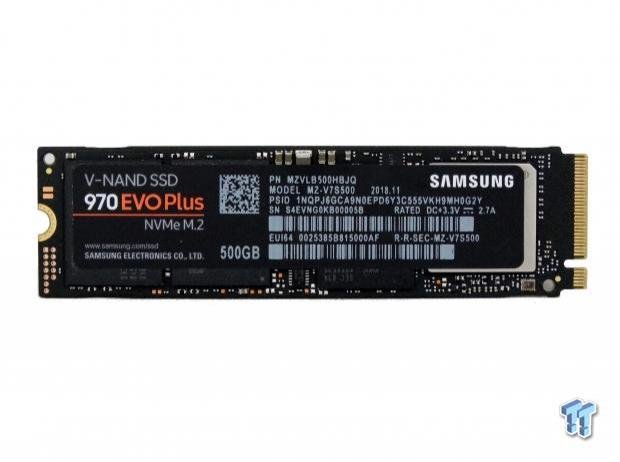
The 970 EVO Plus is the first to use 96-layer memory technology that may not be exactly 96 layers. The company calls it 9x-layer, but we prefer the generic 96 number since that's the target for most companies. Samsung is the first company to build a NAND stack this high without using string-stacking technology that virtually glues two small die together. It's really a technological marvel but outside of tech nerds, most people could care less about the fine details.
The broad strokes that people care about revolve around three key areas, performance, reliability, and cost. Samsung's 96-Layer NAND features the fastest bus speed with 1.4Gbps throughput between the controller and the flash. The memory uses less power than the previous generation while breaking records for 3-bit per cell latency.
Specifications
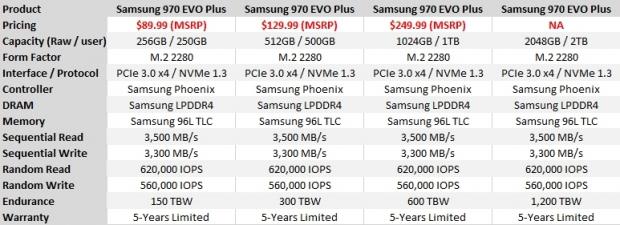
On paper, the new Samsung 970 EVO Plus is an absolute beast. There are four capacities like the original 970 EVO, 250GB, 500GB, 1TB, and a 2TB model.
Samsung tapped the Phoenix controller that powers most of the modern NVMe drives from the company including the 983 ZET "Z-NAND" enterprise SSD that rivals Intel's Optane in responsiveness. Still, the controller is the same as the previous generation, and the newfound performance comes from the memory that we already discussed.
The sequential read performance peaks at the upper atmosphere of PCI Express 3.0 x4, 3,500 MB/s. The sequential write performance is the highest on record yet, 3,300 MB/s. This is 300 MB/s higher than the new drives with the Phison E12 and Silicon Motion, Inc. SM2262EN controllers and a full 1,000 MB/s more than the 500GB EVO released less than a year ago.
The random performance also breaks new ground. Samsung claims up to 620,000 read and 560,000 write IOPS for all four capacities.
Features
A 970 EVO Plus carries over support for TCG Opal and Microsoft's eDrive. There are very few retail consumer SSDs shipping today with self-encrypting drive (SED) technology on the market today. The EVO Plus features AES 256-bit hardware-based encryption to keep your data safe while also keeping performance high compared to software-based encryption engines.
Samsung made enhancements to Dynamic Thermal Guard (DTG) to deliver longer sustained writes, at a higher speed, before throttling the drive.
Pricing, Warranty, and Endurance
Samsung only released pricing details on the 250GB, 500GB, and 1TB models. The 2TB will come to market later this year, and market conditions will determine pricing. For now, the 970 EVO 250GB costs $89.99, and that increases to $129.99 for the 500GB. The 970 EVO 1TB carries an MSRP of $249.99.
The endurance ratings stayed the same as the previous generation with 150 TBW for each 256GB block of memory.
Value-Add Accessories
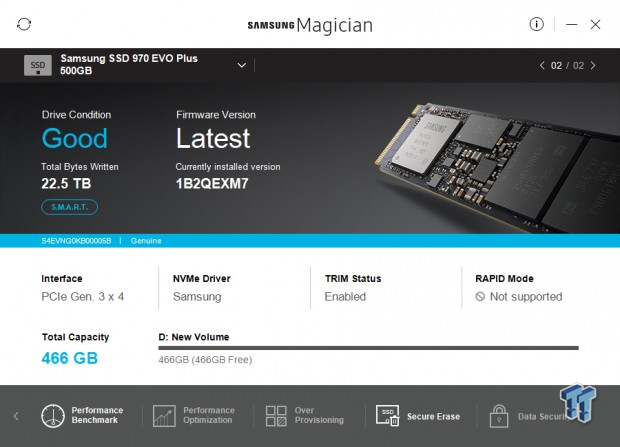
The 970 EVO Plus series works with Samsung's Magician and Data Migration tools.
A Closer Look
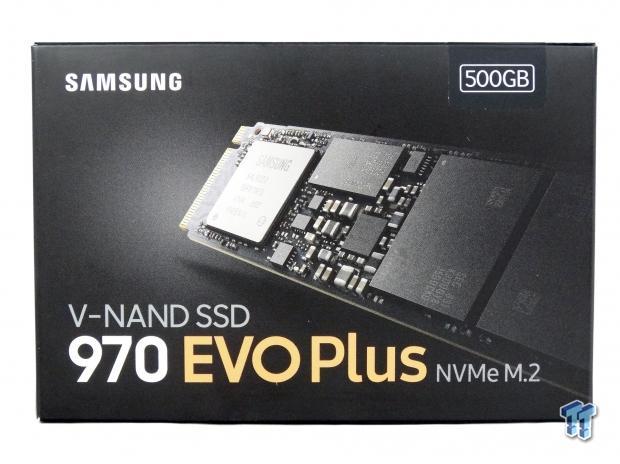

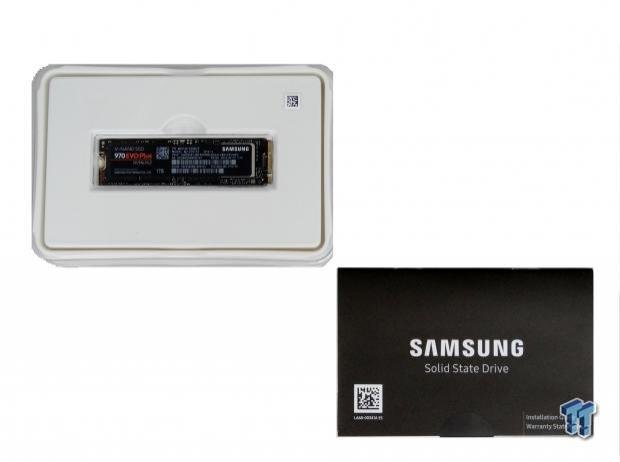

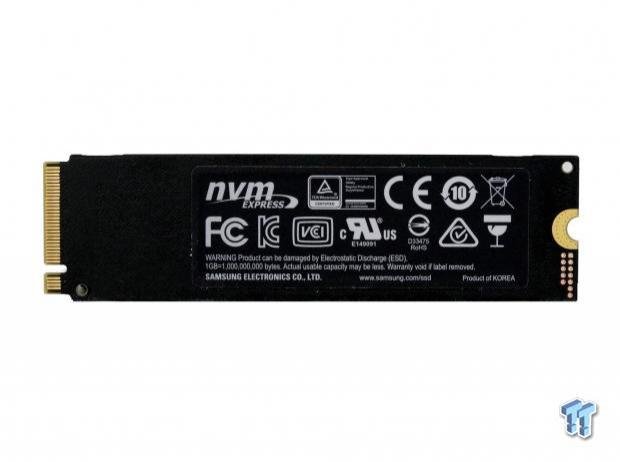
The 970 EVO Plus didn't change much on the outside compared to the previous generation. The drive still packs the components on one side making it usable in notebooks that cannot accept a double-sided M.2 SSD. On the back of the drive, there is a special sticker that uses a copper strip inside to spread the heat generated by the components on the other side.
512GB Class Performance Testing
Product Comparison
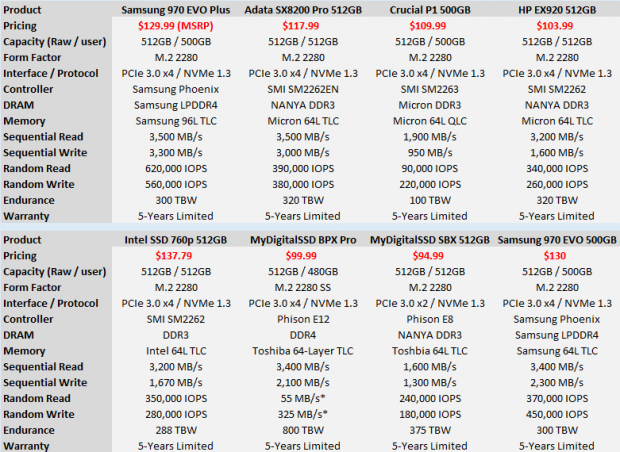
The Samsung 970 EVO Plus joins several new high-performance models recently released. The most notable is the ADATA SX8200 Pro, MyDigitalSSD BPX Pro, Western Digital Black SN750 and HP EX950 (latter two not in the test group today).
Sequential Read Performance
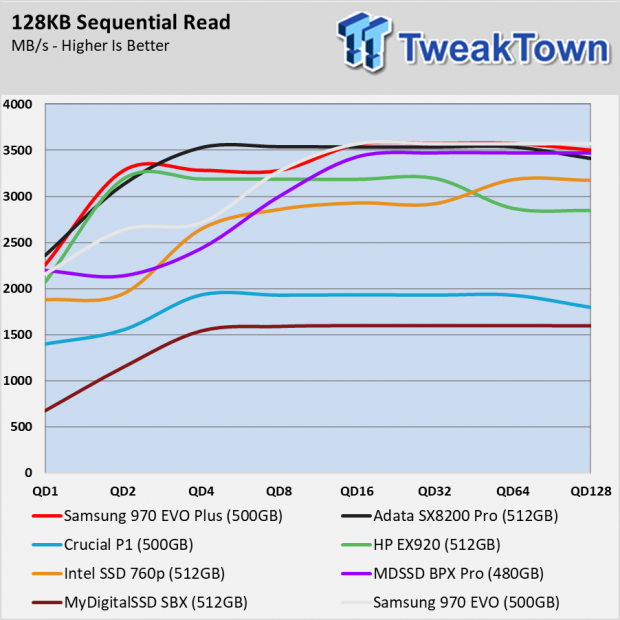
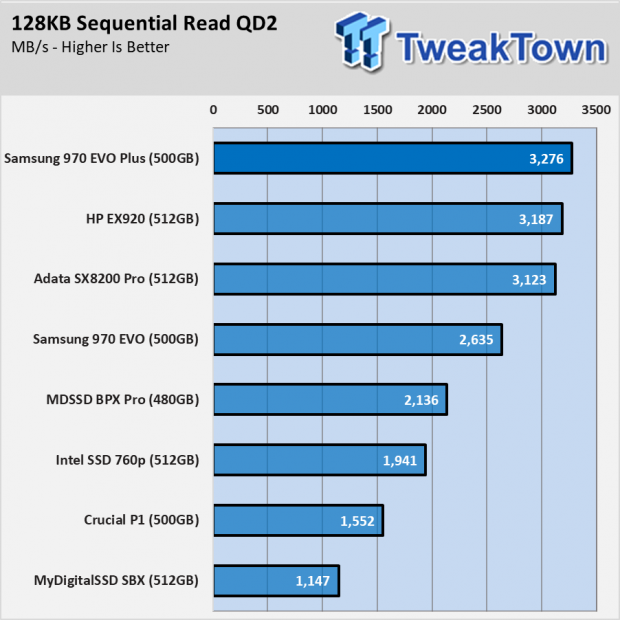
In the 512GB class, the new 970 EVO Plus is significantly faster than the previous generation with sequential large-block data reads. The new drive brings the performance up to 2019 standards with an aggressive slope between queue depths 1 and 2 before leveling off.
Sequential Write Performance

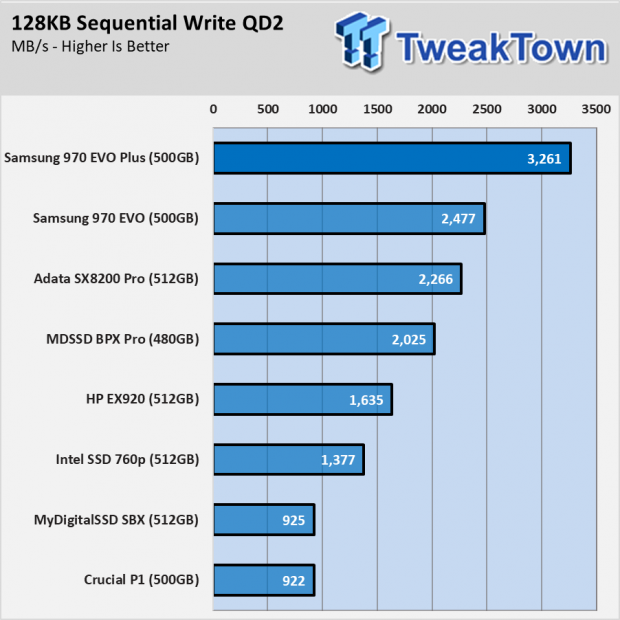
The EVO Plus walks away from every other drive in the sequential write test using bursting 128KB blocks. The 970 EVO delivers right around 2,500 MB/s peak, but the new EVO Plus pushed the envelope to around 3,300 MB/s.
Sustained Sequential Write Performance
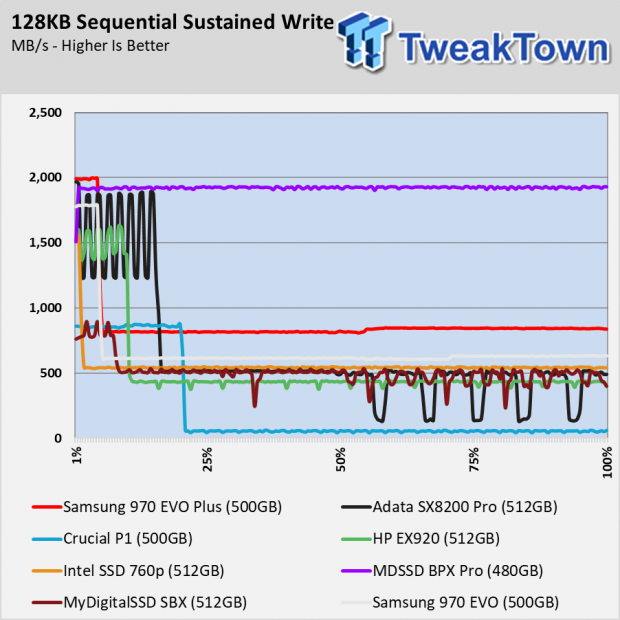
The sustained write test shows the 500GB EVO Plus uses a less aggressive SLC cache size, but we don't need the test to tell us that. Samsung lists the TurboWrite (SLC) size in the specifications. There is a fix level and a dynamic level that shrinks and grows depending on the amount of data you have on the memory.
Random Read Performance
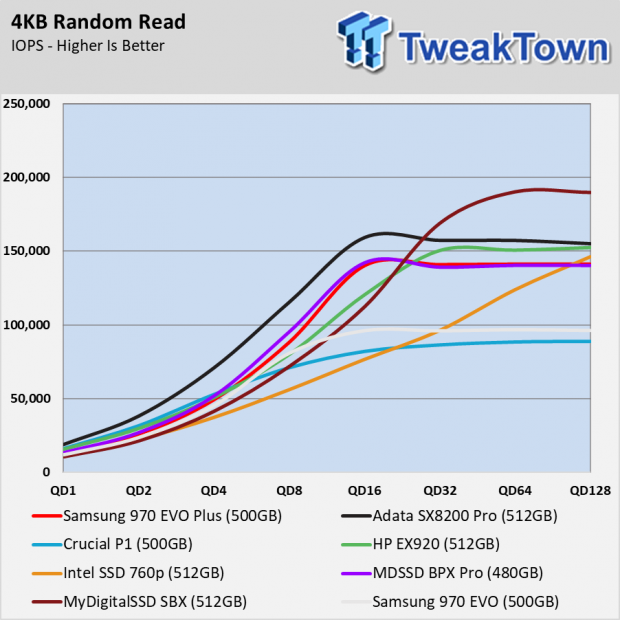

Samsung managed to increase the random read performance with the EVO Plus over the previous generation, but this new series is not as quick as those with Intel Micron Flash Technologies NAND are. There is a massive gap between the ADATA SX8200 Pro with the new Silicon Motion, Inc. SM2262EN controller paired with Micron 64-layer TLC memory. In this capacity, the EVO Plus doesn't surpass the MyDigitalSSD BPX Pro 480GB at low queue depths.
Random Write Performance
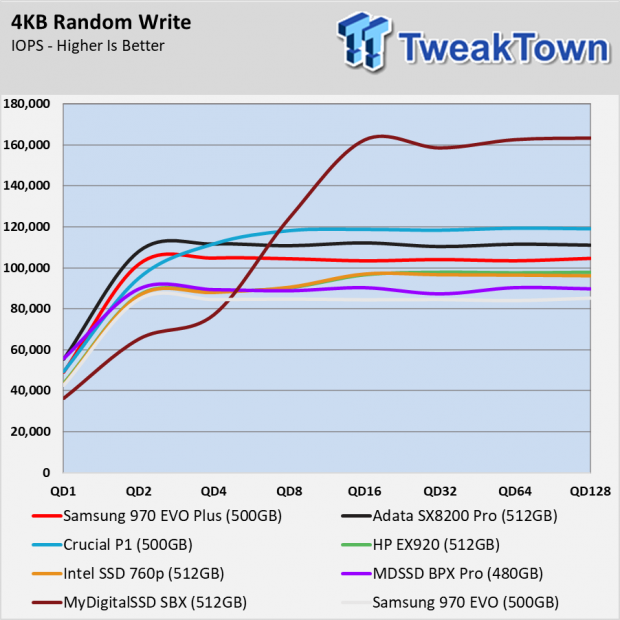

The 500GB EVO Plus outperforms the previous generation in random writes but still struggles to keep pace with the SX8200 Pro and even the Crucial P1 using 4-bit per cell flash. In consumer workloads, random writes usually land in the SLC buffer. We're surprised to see the EVO Plus not dominating this test with the new 5th generation V-NAND technology that was designed to deliver 2-bit per cell level performance.
70% Read Sequential Performance
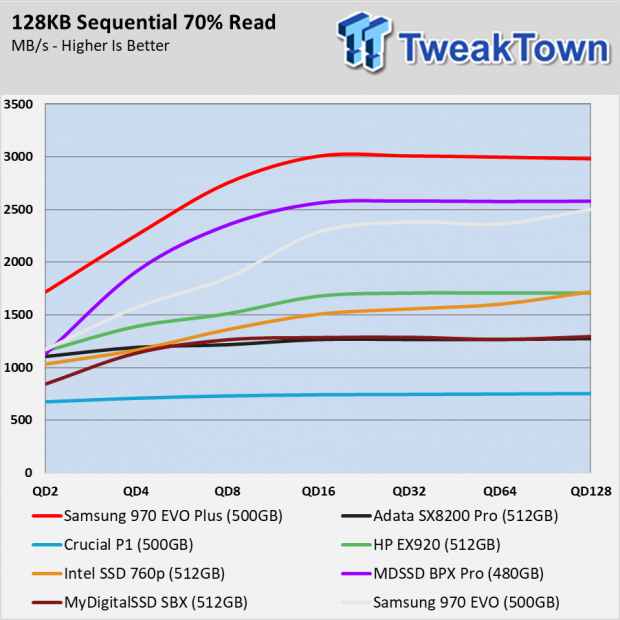
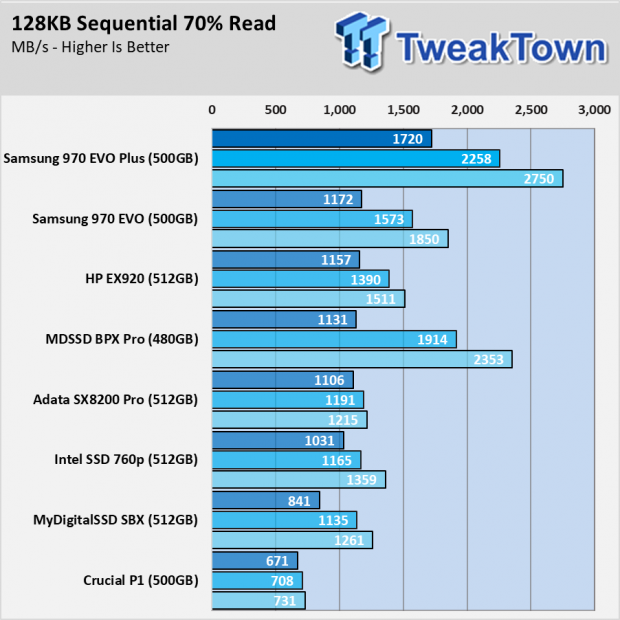
Samsung's massive sequential performance leads come through in the mixed workload test using 70% reads. This workload is similar to many workstation application data feeds to the storage system. In our 1TB review of the 970 EVO Plus, we stated this is the first workstation-class 3-bit per cell SSD and we stand by that for the 500GB model as well.
70% Read Random Performance

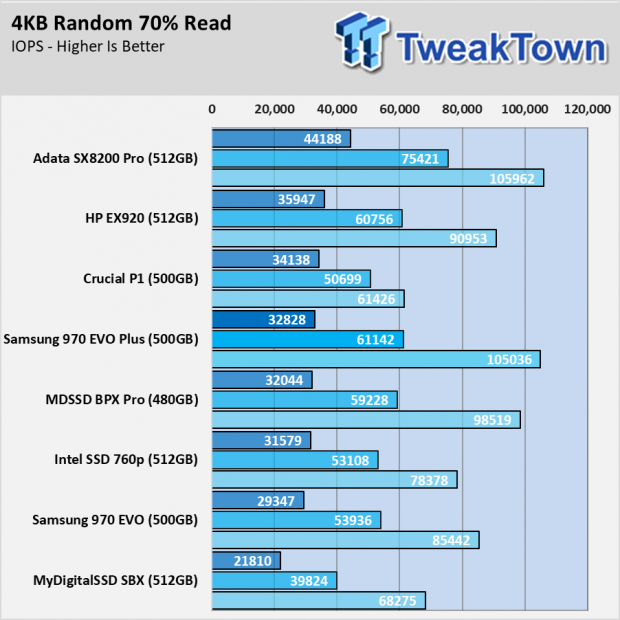
The new 970 series only competes with the drives released in 2018 and earlier when it comes to mixed random data. The new ADATA SX8200 Pro walks away from the group thanks to the new SM2262EN controller and 64-layer IMFT memory.
512GB Class Real-World Performance Testing
Game Load Time
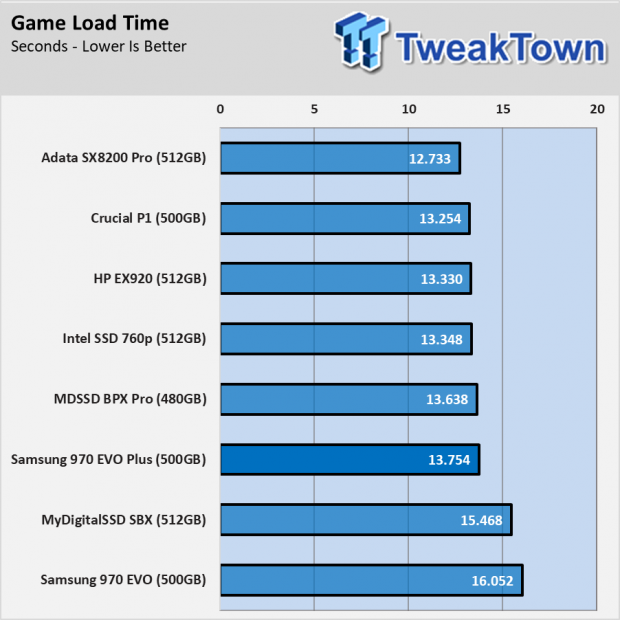
The lower random read performance pushes the 500GB Samsung 970 EVO Plus down the Game Load Time performance chart. It takes nearly 1 second longer to load the Final Fantasy: Stormblood levels compared to the best on the chart today. That one second split contains six strong SSDs.
PCMark 8 Total Storage Bandwidth

Moving to a wider range of applications, the 500GB EVO Plus fairs much better thanks to higher sequential performance. The EVO Plus still trails the MyDigitalSSD BPX Pro and ADATA SX8200 Pro in the same 512GB capacity class.
PCMark 8 Extended Storage Test

The performance looks much different under heavy workloads and right after a healthy dose of data writes. Samsung usually has superior background and predictive garbage collection to keep performance high even under stressful workloads. The new 970 EVO Plus improves on the original 970 EVO and even gets very close to the performance on tap from the 970 Pro (not in the charts today but you can see it in the 1TB EVO Plus review).
SYSmark 2014 SE System Responsiveness and Power Tests
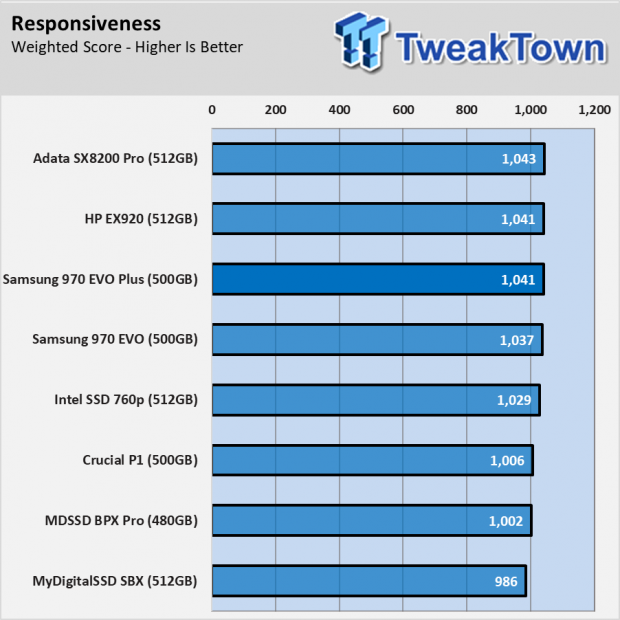

The Responsiveness Test comes from BAPCo's SYSmark 2014 SE suite. The test measures overall system responsiveness (latency) and presents it as a weighted score. The base score is 1,000, and it comes from an OEM variant of the Samsung 850 EVO.
The 970 EVO Plus performs well in the test that focuses on office workloads.
Notebook Battery Life

The 500GB EVO Plus scored just 308 minutes in our Lenovo Y700-17 gaming notebook in the BAPCo MobileMark test. The time is ten minutes less than the previous generation EVO and at the bottom of the list for the drives tested.
Final Thoughts
The Samsung 970 EVO Plus is a strong SSD, but it doesn't dominate the consumer market segment like the series once did for many consecutive years.

We've tested the two mid capacity models now in our lab, the 1TB, and 500GB, and can make some general statements about the series as we see it now. The 970 EVO Plus doesn't deliver the same general computing "snappiness" as the competitor's NVMe offerings using the Silicon Motion SM2262/SM2262EN controllers paired with IMFT 64L TLC memory. What it lacks in general computing, it makes up for under heavier workloads.
The 970 EVO Plus is the closest flash-based NVMe SSD to the powerful 970 Pro under heavy write conditions. Samsung's competitors have yet to master this art. The company likely sees the EVO Plus's random performance under light workloads sufficient while focusing on workloads that are more complex.
The 970 EVO Plus certainly carries a higher price over the other consumer NVMe SSDs. When you need higher performance for intensive workloads, it's a small price to pay.
